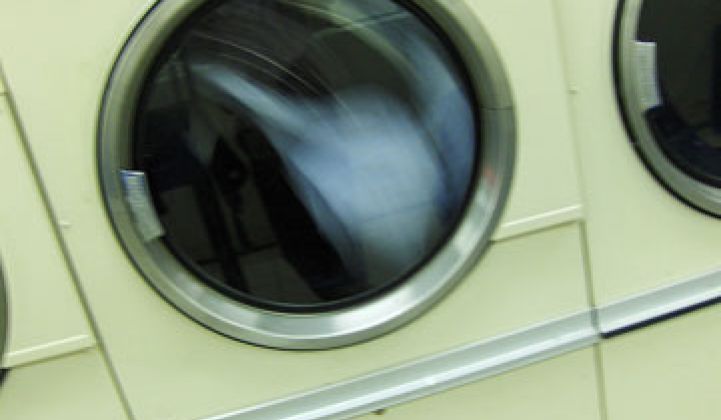We’ve all been there. You take a load of clothes out of the dryer only to find that the pair of jeans you want to throw on aren’t completely dry.
Although occasionally frustrating, it’s hardly a mystery. Heavy denim just takes longer to dry than those polyester blend workout clothes that might be tumbling around with the jeans.
The variety of real-life laundry is a problem not only for people looking for their favorite pair of pants on short notice, but also for the government.
Clothes dryers can account for up to 6 percent of residential electricity consumption in the U.S. While dryers have gotten more efficient overall, they bear no Energy Star label, as their clothes-washer cousins do. The outdated testing standards mean that dryers are falling behind as other energy hogs, such as hot water heaters and air conditioners, become increasingly efficient and start to be vetted by Energy Star.
The missed opportunity can be rectified, according to a study from Ecova about better testing in residential clothes dryers. “The problem is that in real life, some dryers use a lot less energy than other dryers,” said Gregg Hardy, VP of research and policy at Ecova, an energy and sustainability management company that often works with utilities and government agencies. “Most people use the moisture-sensing [feature] to turn off the dryer.”
Before we get to the issue of moisture-sensing, one of the most glaring problems is the current test procedure. The DOE uses napkin-size polyester-cotton blend cloths, said Hardy. Those are weighed completely dry, then water is added and they are occasionally taken out and weighed as they dry. Of course, nobody has an entire dryer full of homogenous polyester napkins. The result, according to Ecova, is that dryers likely use 35 percent more energy when drying cotton-heavy loads.
The second major problem is that the DOE test procedure ends a drying cycle when the cloths have 2.5 percent to 5 percent of remaining moisture content. The complaint is that this essentially sidelines the energy savings potential of automatic shutoff. Because the DOE doesn’t test for this feature, there is no evaluation of which brands have more effective automatic shutoff mechanisms.
The study by Ecova also looked at the energy source and found that gas dryers used far less energy than electric dryers. Also, there is not the loss of energy with gas as there is with electricity. About one-quarter of Americans had a gas dryer as of 2001, according to the EIA. But there are even more options. In Europe, heat-pump dryers, which Hardy described as a dehumidifier in a box with a fan, are widely used.
Saving maybe 2 percent of residential energy use might not seem like much, but increasing efficiency through more robust testing procedures is likely to save more energy than smart appliances that could respond to price signals from a utility. (Smart appliances would likely be the most energy-efficient of them, anyway.) Increased standards don’t require people to change their behavior.
Another appliance that could also benefit from updated testing procedures to better reflect the real world is the refrigerator, says Hardy. He noted that testing could be done with the front-facing icemaker off, even though the icemaker makers in the front “are like a wide-open door where the air can come out.”
Ecova also found that both groups are interested in writing better standards, and now that this is on the radar, there could be changes in coming years. “This is an a-ha moment in the past few years,” said Hardy. Now comes the work to turn a-ha into action.



